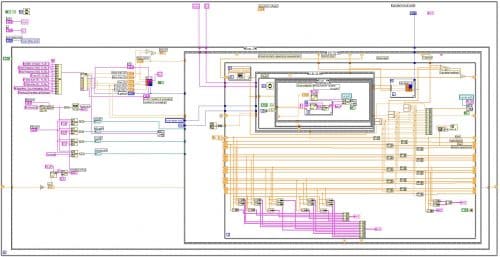LabVIEW Assignment Help
Contents
- 1 LabVIEW Assignment Help
- 2 Understanding a LabVIEW workstation in a LabVIEW assignment
- 3 What are the advantages of LabVIEW?
- 4 Topics covered in a LabVIEW assignment
- 5 Why choose topengineeringsolutions.com for your LabVIEW assignments?
- 6 What can students gain by utilizing our services?
- 7 Conclusion
- 8 Sample Coursework Requiring Labview Assignment Help
LabVIEW Assignment Help
Programming and engineering students are often exposed to a LabVIEW assignment to gauge their competence, level of skill, and knowledge. The LabVIEW assignments are sometimes quite complex for the student to comprehend, hence the need for LabVIEW assignment help. LabVIEW stands for Laboratory Virtual Instrument Engineering Workbench. This tool is a structural model and progressive environment for a VPL (visual programming language). Though a graphical language used in LabVIEW is referred to as G, it is quite different from G-code which was previously used by Apple in the 1980’s. LabVIEW is often utilized for acquisition of data, industrial automation of various operating systems which include different versions of Linux, Unix, Microsoft Windows and MacOS, and for the control of instruments.

Labview Block diagram
Understanding a LabVIEW workstation in a LabVIEW assignment
A LabVIEW workstation utilizes a visual programming language to automate the handling and regulation of gadgets in a laboratory setup. For every Virtual Instrument (VI) there are three components which are:
- Front panel
- Port panel
- Block diagram
When tackling LabVIEW assignment, students should understand that the port panel represents the virtual instrument in the block diagrams of another VI. The front panel comes with signs and controls which provide users with ease during extraction or input of information from an already running VI. The front panel functions as a schematic user interface. It defines the outputs and inputs of the particular node via the adapter panel. This ensures that every virtual instrument can be conveniently inspected prior to its installation in a bigger program as a subroutine. The visual plan enables people with no programming experience to create programs by the simple drag and drop method of virtual illustrations of laboratory gadgets. The LabVIEW programming setting eases development of small applications, though this may expose non-programmers to the risk of underrating knowledge needed to produce high-quality programming.
What are the advantages of LabVIEW?
In order to excel in electrical engineering, students in most universities are expected to post good results in their LabVIEW assignments. Below are the advantages of LabVIEW.
Understanding LabVIEW enables students to complete good quality tasks within a short time. A student who has good LabVIEW skills can undertake the task with minimum assistance. There are different components and tools that programmers need to excel. Identifying, understanding, or even using them all can be challenging especially for newbies. LabVIEW users realize that it avails a collection of tools in one setting. This increases compatibility chances since programmers can link wires between functions. Unlike other programming languages such as Java, C++, or C often used for content programming, LabVIEW is superior in that it is a programming setting used in the creation of programs using visual notation, which can also be referred to as disseminating information through connecting practical nodes using wires.
LabVIEW provides a convenient way for users to access abstraction layers for different types of instruments and buses, and instrument hardware drivers. Abstraction layers support user interface software application which interacts with hardware gadgets. LabVIEW driver user interfaces are able to preserve program development time. This tool provides an effective advancement setting for creating tailor made applications that are capable of communicating real-world signals or information in different industries such as engineering and science.
LabVIEW comes with a powerful visual programming language otherwise known as G (graphics). This enhances its efficiency massively. LabVIEW facilitates the fast completion of programs that would otherwise have taken a long time to compose. LabVIEW assignment often requires University students to explain this tool’s flexibility. Basically, it comes with an easy to comprehend graphical user interface which makes it easy to program. LabVIEW is ideal for analyzing concepts, teaching standard programming, principles, simulations, and standard programming.
LabVIEW comes with an improved compiler which evaluates the block diagram and provides a dependable device code. This helps prevent the efficiency charge which can occur as a result of cross compiled or analyzed languages. The compiler recognizes code sections which lack information dependencies and instantly divides the application into many threads that are capable of running on multicore or parallel processors. This results into accelerated response control and analysis in comparison with consecutive or single threaded applications.
LabVIEW assignment helps students understand how to utilize LabVIEW’s debugging tools to decrease execution and view circulation of information via the diagram. Users can also utilize typical tools which include breakpoint probes and information to peruse the program by each node. Due to a blend of high-quality foundation and improved presence in the application, users can find bugs in a code within a short time. LabVIEW, computer systems, and plug in hardware are made of easy to configure virtual instrument for convenience in task achievement. Users can utilize LabVIEW to construct the required virtual instrument.
Topics covered in a LabVIEW assignment
LabVIEW assignment help is usually part of our Electronics Engineering as well as Electrical Engineering Homework Help service.
Some of the topics include:
- Assignment Help requiring LabVIEW programming principles
- Homework Help for LabVIEW environment
- Simple design patterns
- LabView Assignment Help involving Error handling
- LabVIEW Assignment Help in Sub VI design
- Homework Help for Labview Debugging tools and techniques
Why choose topengineeringsolutions.com for your LabVIEW assignments?
Topengineeringsolutions.com are experts in the provision of assignments. We are the best when it comes to producing assignment and projects which need the use of engineering software. The following are the services we have exceptional prowess in.
- Engineering Final Year Project Proposal
- 3D and 2D Modeling
- Mathematics with special reference to algebra, statistics, pde, and calculus
- Programming assignment help
- Engineering Lab Reports
- Finite Element analysis (FEA) and Computational fluid dynamics (CFD)
- Engineering Coursework
- Engineering Industrial Attachment Report/practicum report
- Dissertation/Thesis/Final Year project
- Engineering Essay
- Engineering Term Paper
- LabVIEW Assignment Help
What can students gain by utilizing our services?
At topengineeringsolutions.com, we pride ourselves in numerous years of experience handling student homework, projects, and assignments including LabVIEW assignment Help. Students are guaranteed of accurate, non-plagiarized, and error free work. We have a team of qualified and skilled professionals who are dedicated and committed to satisfying the needs of the students. Our 24/7 customer support comes in handy to help students reach us any time of the day. Our experts will steer a student’s grades towards improvement.
Conclusion
Students today do not have to struggle with difficult subjects. The availability of assignment writing services has helped them to create time for other activities such as research and preparation for their exams. Topengineeringsolutions.com experts help students by developing their research and writing skills. We are committed to helping the student grow and enhance their skills in preparation for their future careers.
Sample Coursework Requiring Labview Assignment Help
Coursework Title: Temperature Control Using LabView and K8055 I/O Card
Module Name: Applied Instrumentation
The object of this assignment is to control the temperature of a heated system using a DC cooling fan. It could be considered as a model for an air conditioning system or some sort of industrial plant cooling system. The system to be used is described in the document
“Hardware Info”.
The fan will be connected to a K8055 I/O card and will use a LabView control system.
The complexity of your control system is up to you. Extra (useful) features will attract more
marks.
As a minimum requirement, a user should be able to enter a SET temperature, which the
control system should attempt to maintain. It can only do this by modifying the speed of the
cooling fan because the heat fed into the system will be constant. (Note that this system
cannot cool below room temperature because it is only blowing room temperature air!) The
system should display the present READ temperature.
When a “STORE DATA” button is pressed, the system should store the next five minutes’
SET and READ temperatures to a file (using a sensible time between data points!!) This file
should be used later to produce an Excel graph showing the effectiveness of the system
over the five minute period. Sufficient controls and indicators should be used on the Front
Panel so that a user knows what is happening.
Examples of extra features (think of others yourself) that might be implemented:
- Use one of the shaft encoders we looked at last semester to enter the SET temperature instead of a Front Panel numeric control, displaying the SET value on a Front Panel numeric indicator.
Display the fan speed setting. - Display the fan speed reading using the K8055 counter CTR1.
- Generate an alarm if the fan set and read values differ significantly.
- Display a Waveform Chart showing SET and READ temperatures on a scrolling display, so that the movement trend of READ towards SET can be observed over a few seconds.
- Implementation of Proportional + Integral (PI) control on your system (in this application a derivative term (full PID) won’t help).
- Read a stored SET temperature profile from a file generated in Excel.
SubVIs
Emphasis should be placed on the use of subVIs in your solution to this problem (as required by proforma learning outcome LO4). An example of a simple subVI might be a VI that converts the present value of the K8055 counter CTR1 into a reading of fan speed. The strobe output of the fan could be connected to K8055 digital input 1 (which increments CTR1) so that the counter increments all the time that the fan rotates. If the counter is read once per
second, then the subVI might calculate the fan speed in RPM as follows.

The division by 2 reflects the fact that the fan generates two pulses per revolution.
You may decide that reading the counter once a second is not the best solution, so your own
VI’s arithmetic may be different.
Assessment
Assessment of this assignment will be by a written report of not more than 3000 words, plus diagrams. Properly labelled and commented Front Panels and Block Diagrams will reduce the need for textual descriptions and explanations.
Mark allocation will be as follows.
Front Panels 15%
Block Diagrams 40%
Use of subVIs 15%
Testing 20%
Presentation 10%



